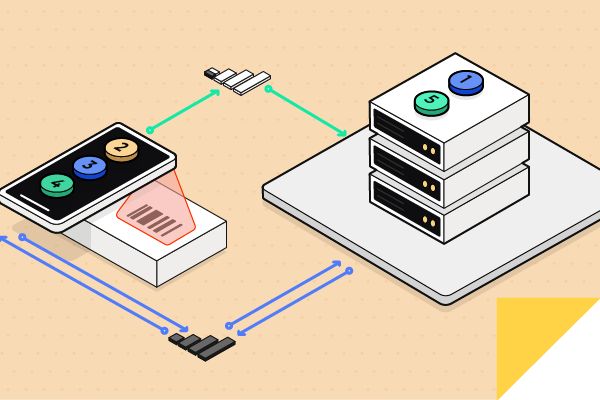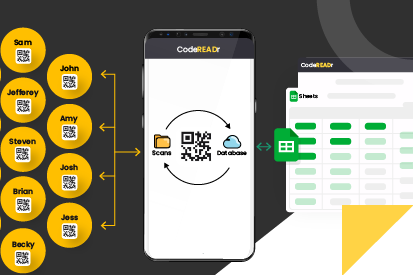August 19, 2024 • 2 min read
Optimizing GS1 Barcode Scanning: Scan, Decode, and Convert with CodeREADr

CATEGORIES
SOCIAL SHARE
Efficiently Scan, Decode, and Convert GS1-Compliant and Non-Compliant Barcodes
When it comes to barcode scanning, decoding, and converting, the CodeREADr barcode scanning app is a versatile solution. It can handle GS1-compliant and non-compliant barcodes, ensuring seamless integration into any system. Whether you’re dealing with fully compliant GS1 barcodes or legacy codes that don’t meet GS1 standards, CodeREADr has you covered.
Understanding GS1 Barcode Standards
GS1 barcode standards are globally recognized for their ability to encode essential data like product identifiers, batch numbers, and expiration dates. These data points, known as Application Identifiers (AIs), are critical for effective product tracking throughout the supply chain. However, extracting this data accurately requires the right tools, especially when dealing with GS1-compliant barcodes.
The Challenge of Non-Compliant Barcodes
Not all barcodes featuring Application Identifiers (AIs) are GS1-compliant. Creating GS1-compliant barcodes necessitates a deep understanding of AIs and their correct structuring to ensure interoperability. Non-compliant barcodes can pose significant challenges during scanning, leading to issues with data capture and processing in the field.
Advanced Barcode Scanning with Regex Patterns
To address these challenges, CodeREADr promotes interoperability by allowing businesses to leverage regex patterns and replacements for AI data extraction. Regular expressions, or regex, are powerful sequences of characters that define search patterns. They are particularly effective for identifying and manipulating specific data within strings, making them ideal for parsing GS1 barcodes.
How CodeREADr Streamlines Barcode Scanning
When a GS1-compliant barcode is scanned using CodeREADr, predefined regex patterns come into play to identify and extract the embedded AI data. For instance, a barcode might contain multiple data elements, such as a Global Trade Item Number (GTIN), lot number, and expiration date. With the appropriate regex patterns, CodeREADr isolates each piece of data and presents it in a usable format.
For non-GS1-compliant barcodes, the process is more complex, often requiring multiple regex patterns and replacements. The CodeREADr platform’s Custom On-Device (COV) feature simplifies this by allowing mobile app users to automatically capture the required data, regardless of barcode compliance. This ensures that the correct data is captured effortlessly during scanning sessions.
Barcode Scanning in Logistics: The Importance of Interoperability
In logistics, interoperability is key. A distributor often needs to scan barcodes from various suppliers, some of whom may not adhere to GS1 standards. To manage tasks like picking, packing, shipping, and delivery efficiently, the distributor must scan both compliant and non-compliant barcodes.
CodeREADr’s mobile barcode scanning app addresses this need by providing a robust solution for scanning a wide range of barcodes. However, even with the COV feature, custom programming may be necessary in some cases. For optimal results, it’s strongly recommended that all suppliers comply with GS1 standards.
Benefits of Using CodeREADr for Barcode Scanning
- Accuracy and Efficiency: Automating AI data extraction reduces human error, ensuring accurate and reliable data capture.
- Versatility: CodeREADr supports a broad range of 1D and 2D barcodes, making it suitable for industries such as retail, healthcare, and logistics.
- Customizability: Businesses can customize regex patterns to meet specific needs, allowing for precise data extraction.
- Integration: The extracted data can be seamlessly integrated into existing systems, improving operational efficiency and data management.
What is a GTIN?
A Global Trade Item Number (GTIN) is a unique GS1 identification key used to identify trade items. GTINs can be 8, 12, 13, or 14 digits long and are essential for product identification, whether online or in physical stores.
- GTIN 12: Common in North America, synonymous with UPC, and encoded in UPC-A barcodes.
- GTIN 14: Used for trade item groupings, like product cases, and not intended for point-of-sale use.
- GTIN 8: Used for small items outside North America, intended for point-of-sale scanning.
- GTIN 13: Predominantly used outside North America, synonymous with EAN, and encoded in EAN-13 barcodes.


